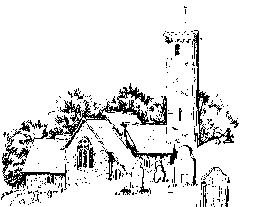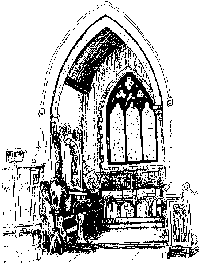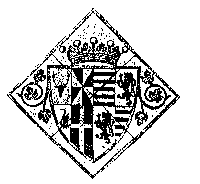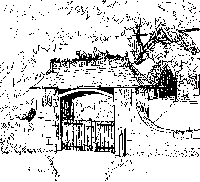Stackpole Church
 |
Stackpole Church, near Pembroke and within clear sight of
heaven
- if you are looking in the right direction - is dedicated to
St. James and St. Elidyr, and goes back probably to the 12th.
century. It is situated in the village of Stackpole Elidor, otherwise
known as Cheriton on the Castlemartin peninsula of Pembrokeshire,
that special part of Wales, often referred to by its inhabitants
as Little England beyond Wales. This reflects the long history
of anglicisation in the area, dating right back to Norman times,
who held the area as an important trading and staging post to
Ireland. The large number of Norman castles in the small area
testifies to the importance it held in their eyes. The locality
has been completely English speaking since those times. |
Dedication
The dedication to St. James and St. Elidyr (or Elidor) is of interest
from two points of view. The St. James is, by tradition, the disciple
and apostle St. James, and therefore the first martyr among the
apostles, put to death by King Herod, as described in the Acts
of the Apostles.
St. Elidyr is a bit more of a puzzlement. According to Henry Owen,
in his book on Old Pembrokeshire Families, "Elidor de Stackpole
founded the Church of Stackpole Elidor or Cheriton, and like other
founders was afterwards to be the patron saint." It is generally
considered that this is a correct assessment of the situation.
It may well have been originally dedicated just to St. James,
and an indication of this possibility is that as late as 1733
Browne Willis in his Parochiale Anglicanum names St. James as
the sole patron of the Church of Stackpole Elidor. Quite possibly
the founding knight's name, Elidor, already incorporated in the
name of the Parish (See A Short History of Stackpole), became
associated with the St. Elidor or Elidyr who was already established
in the Church Calendar, and thus became added as a co- patron
of the Church. Such popular forms of canonisation are by no means
uncommon. It would appear that the actual St. Elidor that the
confusion took place with is in fact St. Teilo or Eliud. There
are three other Pembrokeshire churches dedicated to St. Elidyr
- Amroth, Crunwere and Ludchurch. These are referred to in the
12th. century Book of Llandaff as belonging to the "patrimony
of St. Teilo". Stackole does not appear on the list, so it
looks unlikely that it was originally a St. Teilo dedication -
further evidence that Henry Owen's theory above is correct.
The Appearance of the Church
 |
The layout of the Church is in the traditional
cruciform shape,
aligned East to West, with a chancel and nave flanked by two transepts.
The tall, slender tower is undoubtedly the oldest part of the
present structure, dating back probably to the 13th. or late 12th.
century. It is of the typical South Pembrokeshire form, if anything
even more slender than usual, and at present without stringcourse
or battlement.
|
It appears that by 1851 the state of the fabric of the Church
made a complete restoration essential, although the building had
been carefully maintained until only a few years before. Richard
Fenton, in his "Historical Tour through Pembrokeshire"
published in 1810, quotes from a letter written by Stephen Davies,
Canon of St. Davids Cathedral, to the antiquary Browne Willis,
"Here I cannot forbear mentioning the generous beneficence
of that worthy gentleman, John Campbell Esquire, to the parishes
of St. Petrook, Cheriton or Stackpool Elidur and Bosherston on
his first coming to the possession of his estate, being about
the age of twenty. He waiscotted the three chancels, and otherwise
adorned them in a very decent and handsome manner, made new rails
about the altar, bestowed new cushions and pulpit cloths and a
new set of Communion plate to each." In 1807 the churchwardens
stated that the Church was in good repair, but by 1828 they declared
that the fabric, though in good repair, was very damp, and by
1848 it was recorded that "not one casement opens".
In 1851 John Frederick, first Earl Cawdor, engaged Sir George
Gilbert Scott, the most respected English Church architect of
the day, to direct the work of restoration. He employed a Cardiff
builder, W. P. James, and the work cost a total of £1804
7s 2½d. The result, it is generally agreed, is the typical
sound, workmanlike building that Scott prduced in his renovations,
with a typical tall, narrow chancel arch, colourful Minton tiles
on the chancel floor and sanctuary walls, and the typical Middle
English or Decorated style of tracery in the main windows. The
transepts retain their 14th. century vaulting, and the Lort chapel
its rib vaulting. There were originally matching squints or hagioscopes
on each side of the chancel arch, though the north squint was
later blocked by the organ installed in 1874. In the south transept
there is a small piscina, probably of the 14th. century, which
indicates there was probably a side altar there at the time.
Monuments
In the chancel there are two striking effigies on tomb chests,
traditionally identified with the founder of the Church, Sir Elidor
de Stackpole and his wife, the Lady Elspeth. The style of the
two effigies is considered to be considerably later than their
period, but it was not uncommon for descendents to erect monuments
to long dead forebears in contemporary style, as many Church brasses
bear witness. The legs of the knight's effigy are crossed, commonly
interpreted as showing that the knight had been to the crusades.
According to tradition, Sir Elidor de Stackpole went to the Crusades
with Richard I, though Henry Owen discounts the story.
 |
High up over the organ on the north wall of the chancel there
is a marble memorial in the Italian Gothic style to Rear Admiral
the Honourable George Pryse Campbell, and in the south transept
there is a memorial to Ronald Elidor Campbell, killed in the Zulu
war in 1879. One of the two large hatchments on the north wall
of the nave is that of the first Earl Cawdor, whose arms also
appear in the tiling of the chancel floor, impaled with those
of his wife. The other is the arms of Sarah Mary, Countess Cawdor,
wife of John Frederick Vaughan, second Earl Cawdo
. |
The Lort Chapel
On the south side of the chancel there is a small chapel, known
as the Lort Chapel, which contains a number of interesting monuments.
Under the east window there is a rough pillar stone with a damaged
Latin inscription, CAMULORIC -/- FILIFANNUC, Camulorix, son of
Fannucus. Nothing more is known about the stone or its original
location, but it may be that of an early chieftain of the district.
 |
One of the most striking monuments in the chapel
is that to Roger
Lort, Lord of the Manor of Stackpole, who died in 1613. The figures
of Roger Lort and his wife Abertha face each other, and underneath
are depicted their seven sons and five daughters, all in deep
mourning.
|
The most imposing tomb in the Lort Chapel is that of
John first
Earl Cawdor, by John Forsyth.
Windows
The East Window depicting the Crucifixion is also in memory of
the same Sarah Mary, Countess Cawdor of the hatchment mentioned
above. The glass in the small window in the tower was presented
in memory of Frederick Archibald Vaughan, third Earl Cawdor, who
died in 1911 and was Lord Lieutenant of Pembrokeshire, MP for
Carmarthenshire from 1874 to 1885 and First Lord of the Admiralty
in 1905. The glass in the south transept, depicting Lord Cawdor
as Solomon directing the building of the Temple, was designed
by O'Connor and presented to the Church by the inhabitants of
the Stackpole estate in recognition of the first Earl's generosity
in restoring the six Churches on the estate. The glass in the
west window portrays the Law contrasted with the New Law of "as
you do it to the least of these my brethren", but it is not
known when it was installed or by whom.
Bells
The tower contains three bells, dating originally back to the
17th. and 18h. centuries, and recast in 1971. They are no longer
mounted on wheels and are rung by a simple chiming system.
Outside
 |
The lychgate was designed by Christopher Hatton
Turnor (1873 -
1940) in memory of John Frederick Vaughan, second Earl Cawdor,
who died in 1881. Along the ridge are lead representations of
the Galley of Lorne from the Cawdor arms. The designer was the
nephew of the wife of the third Earl, and was a much respected
architect of his day, responsible, amongst other things, for designs
for the Cairo museum. The gate is generally considered to be a
significant example of art nouveau.
|
Stackpole Rectory
At one time the benefice of Stackpole Elidor possessed a Vicar
as well as a Rector. The Rectorship was effectively a sinecure,
and the offices of Vicar and Rector were merged after the death
of the then Vicar, James Summers, who had been instituted in 1814.
In 1839 the Rectory of Stackpole Elidor was united with that of
St. Petrox, and in 1985 further grouped with the Parishes of Bosherston
and St. Twynnells. So now it has only ¼ of a Rector, and
is somewhat less of a sinecure. The Rectory of Stackpole was previously
at St. Petrox, at what is now the Old Rectory Farm. In 1877 a
new Rectory was built at the direction of Lord Cawdor. The whole
complex, including the fine Rectory, with 28 rooms, including
servants quarters on the second floor and 3 cellars, together
with stables, coach house, cowhouse, pigsties and walled garden
cost £3171 9s 0d to build.
Rectors of Stackpole Elidor
1236 William
1343 William de Bergeveney
1486 John Vernon
1510 John Griffith
1522 Richard Shirton
1536 William Latymer MA
1607 Edmund Smyth MA
1616 William Dolben DD
1618 Rice Middleton
1631 Thomas Pritchard
1671 William Lloyd MA
1675 Edmund Meyrick MA
1676 George Owen DD
1691 David Phillips MA
1715 Phillip Brookes BST
1718 Pawlet St. John DD
1732 Richard Lowther
1749 Henry Rowe MA
1780 Charles Pritchett MA
1813 John Jones
1832 Francis Leach MA
1876 James Brown BA
1892 Charles Edmondes MA
1893 Charles Pollock
1895 Francis Hamilton MA
1907 John Davies BA
1912 Edward Roderick MA
1945 Ronald Davies BSc
1956 Evan Jones BA
1956 John Iorwerth Thomas BA
1972 David Barrington Davies MA
1983 John Henry Richards MA BD





